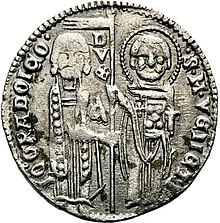Biography
Gradenigo was born in Venice. He was married to Adriana Borromeo and then to Marina Capello. [1] Before his election, he had been podestà in Capodistria, Padua, and Treviso. His recognized loyalty to the Venetian Republic probably helped him in being elected, as he came after the conjure which had led to the execution of his predecessor, Marino Faliero.
Two months after his election, the Venetians signed a peace treaty with Genoa, ending a long and unfavorable war. During his reign, measures were taken to improve the Republic's economic situation, but in 1356, they were again in war both on the mainland and in Dalmatia (which would end in the unfavorable Treaty of Zadar under his successor, Giovanni Dolfin).
He died in August 1356.
This page is based on this
Wikipedia article Text is available under the
CC BY-SA 4.0 license; additional terms may apply.
Images, videos and audio are available under their respective licenses.
